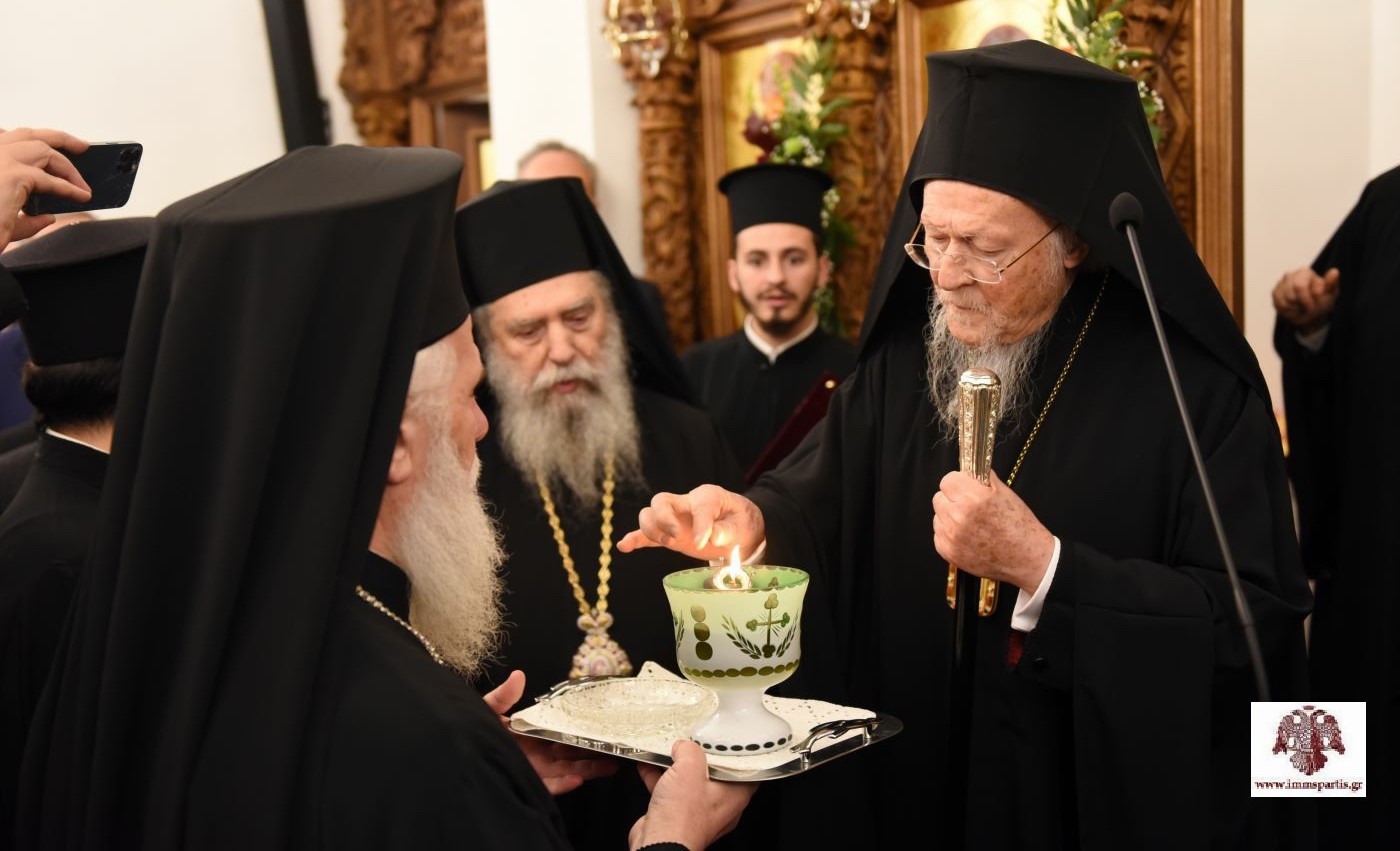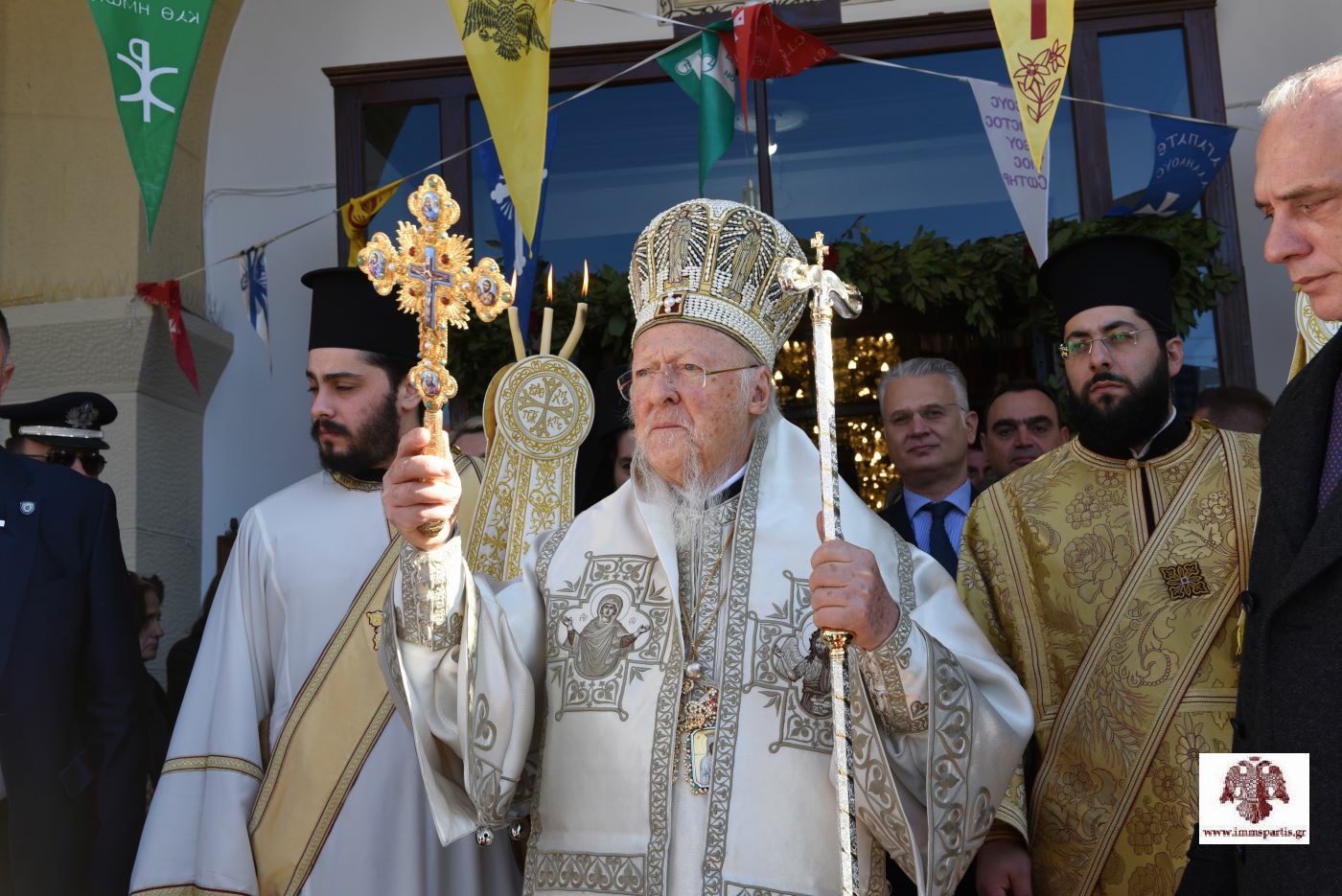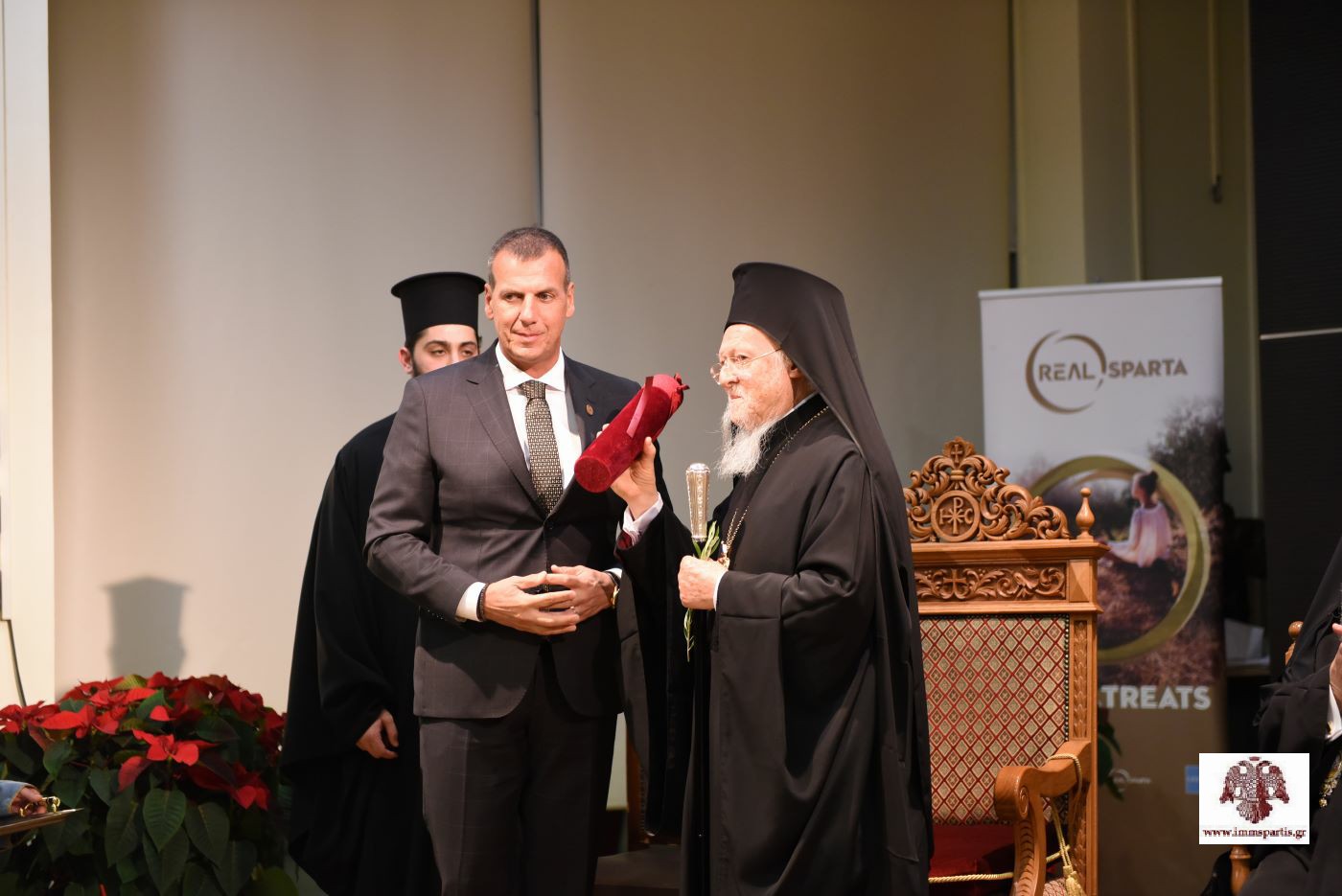Holy Protection of the Theotokos (28 October)
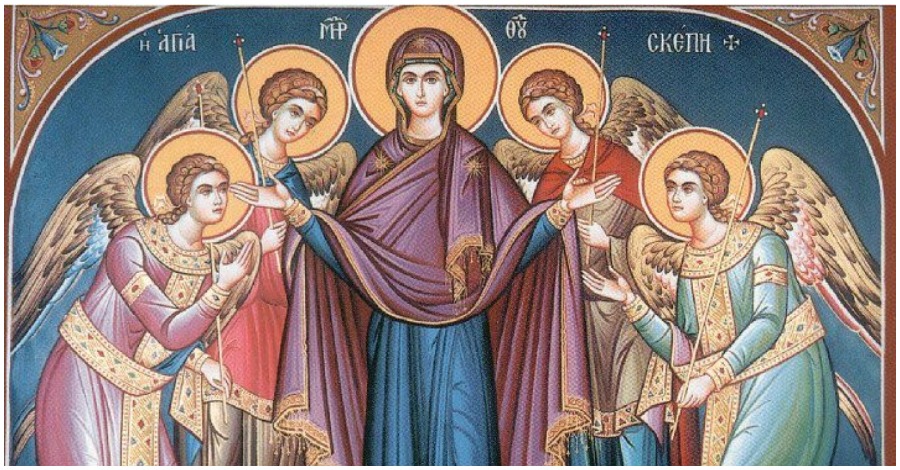

The Feast of the Protection commemorates the appearance of the most holy Theotokos in the Church of Blachernae in Constantinople in the tenth century, as recorded in the life of Saint Andrew the Fool for Christ’s sake. While the multitudes of the faithful were gathered in church, Epiphanius, the friend of Saint Andrew, through the Saint’s prayers, beheld the Virgin Mary above the faithful and spreading out her veil over them, signifying her unceasing protection of all Christians. Because of this we keep a yearly feast of gratitude, imploring our Lady never to cease sheltering us in her mighty prayers.
The Feast is celebrated on October 1. In the 1950s, the Church of Greece began to observe the Feast on October 28.
From time immemorial, the Church has celebrated the Most-holy Theotokos as the patroness and protectress of the Christian people, who, by her intercessory prayers, implores God’s mercy for us sinners. The help of the Most-holy Mother of God has been clearly shown numerous times, to individuals and to nations, in peace and in war, in monastic deserts and in densely populated cities. The event that the Church commemorates and celebrates today confirms the Theotokos’ consistent protection of Christian people. On October 1, 911 A.D., during the reign of Emperor Leo the Wise, there was an All-night Vigil in the Blachernae Church of the Mother of God in Constantinople.
The church was full of people. St. Andrew the Fool-for-Christ was standing in the rear of the church with his disciple Epiphanius. At four o’clock in the morning, the Most-holy Theotokos appeared above the people, holding her omophorion outstretched as a protective covering for the faithful. She was clothed in gold-encrusted purple, and shone with an ineffable radiance, surrounded by apostles, saints, martyrs and virgins. St. Andrew said to Blessed Epiphanius: “Do you see, brother, the Queen and Lady of all praying for the whole world?” Epiphanius replied: “I see, Father, and am struck with amazement!” The Feast of the Protection was instituted to commemorate this event, and to remind us that we can prayerfully receive the unceasing protection of the Most-holy Theotokos in any time of difficulty.
This miraculous appearance of the Mother of God occurred in the mid-tenth century in Constantinople, in the Blachernae church where her robe, veil, and part of her belt were preserved after being transferred from Palestine in the fifth century.
On Sunday, October 1, during the All Night Vigil, when the church was overflowing with those at prayer, the Fool-for-Christ Saint Andrew (October 2), at the fourth hour, lifted up his eyes towards the heavens and beheld our most Holy Lady Theotokos coming through the air, resplendent with heavenly light and surrounded by an assembly of the Saints. Saint John the Baptist and the holy Apostle John the Theologian accompanied the Queen of Heaven. On bended knees the Most Holy Virgin tearfully prayed for Christians for a long time. Then, coming near the Bishop’s Throne, she continued her prayer.
After completing her prayer she took her veil and spread it over the people praying in church, protecting them from enemies both visible and invisible. The Most Holy Lady Theotokos was resplendent with heavenly glory, and the protecting veil in her hands gleamed “more than the rays of the sun.” Saint Andrew gazed trembling at the miraculous vision and he asked his disciple, the blessed Epiphanius standing beside him, “Do you see, brother, the Holy Theotokos, praying for all the world?” Epiphanius answered, “I do see, holy Father, and I am in awe.”
The Ever-Blessed Mother of God implored the Lord Jesus Christ to accept the prayers of all the people calling on His Most Holy Name, and to respond speedily to her intercession, “O Heavenly King, accept all those who pray to You and call on my name for help. Do not let them go away from my icon unheard.”
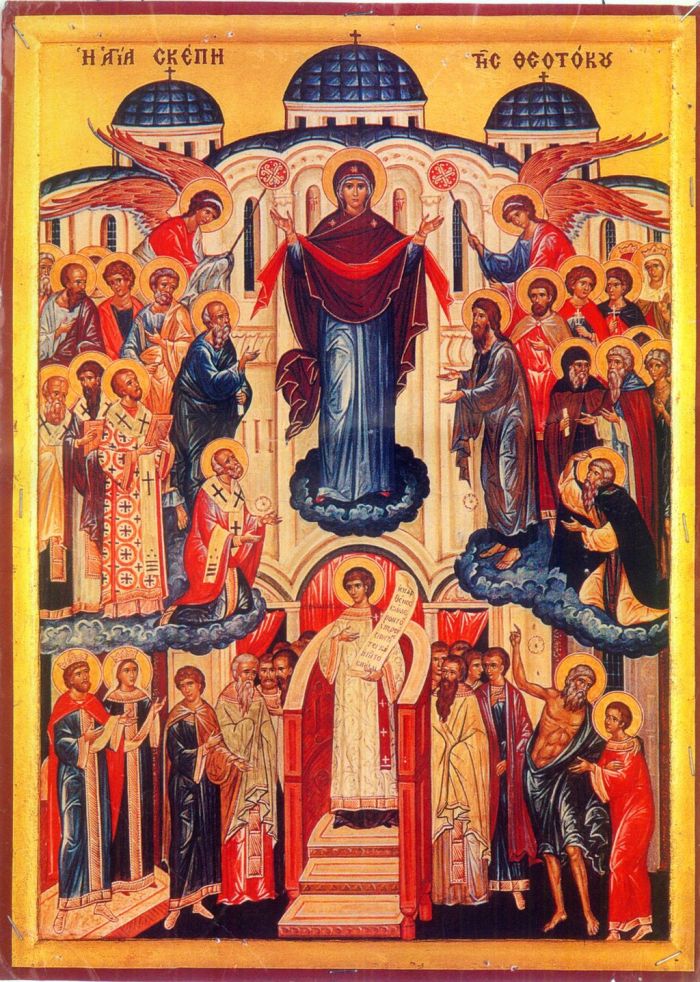

Saints Andrew and Epiphanius were worthy to see the Mother of God at prayer, and “for a long time observed the Protecting Veil spread over the people and shining with flashes of glory. As long as the Most Holy Theotokos was there, the Protecting Veil was also visible, but with her departure it also became invisible. After taking it with her, she left behind the grace of her visitation.”
At the Blachernae church, the memory of the miraculous appearance of the Mother of God was remembered. In the fourteenth century, the Russian pilgrim and clerk Alexander, saw in the church an icon of the Most Holy Theotokos praying for the world, depicting Saint Andrew in contemplation of her.
The Primary Chronicle of Saint Nestor reflects that the protective intercession of the Mother of God was needed because an attack of a large pagan Russian fleet under the leadership of Askole and Dir. The feast celebrates the divine destruction of the fleet which threatened Constantinople itself, sometime in the years 864-867 or according to the Russian historian Vasiliev, on June 18, 860. Ironically, this Feast is considered more important by the Slavs then by the Greeks.
The Primary Chronicle of Saint Nestor also notes the miraculous deliverance followed an all-night Vigil and the dipping of the garment of the Mother of God into the waters of the sea at the Blachernae church, but does not mention Saints Andrew and Epiphanius and their vision of the Mother of God at prayer. These latter elements, and the beginnings of the celebrating of the Feast of the Protection, seem to postdate Saint Nestor and the Chronicle. A further historical complication might be noted under (October 2) dating Saint Andrew’s death to the year 936.
The year of death might not be quite reliable, or the assertion that he survived to a ripe old age after the vision of his youth, or that his vision involved some later pagan Russian raid which met with the same fate. The suggestion that Saint Andrew was a Slav (or a Scythian according to other sources, such as S. V. Bulgakov) is interesting, but not necessarily accurate. The extent of Slavic expansion and repopulation into Greece is the topic of scholarly disputes.
In the Prologue, a Russian book of the twelfth century, a description of the establishment of the special Feast marking this event states, “For when we heard, we realized how wondrous and merciful was the vision… and it transpired that Your holy Protection should not remain without festal celebration, O Ever-Blessed One!”
Therefore, in the festal celebration of the Protection of the Mother of God, the Russian Church sings, “With the choirs of the Angels, O Sovereign Lady, with the venerable and glorious prophets, with the First-Ranked Apostles and with the Hieromartyrs and Hierarchs, pray for us sinners, glorifying the Feast of your Protection in the Russian Land.” Moreover, it would seem that Saint Andrew, contemplating the miraculous vision was a Slav, was taken captive, and became the slave of the local inhabitant of Constantinople named Theognostus.
Churches in honor of the Protection of the Mother of God began to appear in Russia in the twelfth century. Widely known for its architectural merit is the temple of the Protection at Nerl, which was built in the year 1165 by holy Prince Andrew Bogoliubsky. The efforts of this holy prince also established in the Russian Church the Feast of the Protection of the Mother of God, about the year 1164.
At Novgorod in the twelfth century there was a monastery of the Protection of the Most Holy Theotokos (the so-called Zverin monastery) In Moscow also under Tsar Ivan the Terrible the cathedral of the Protection of the Mother of God was built at the church of the Holy Trinity (known as the church of Saint Basil the Blessed).
On the Feast of the Protection of the Most Holy Theotokos we implore the defense and assistance of the Queen of Heaven, “Remember us in your prayers, O Lady Virgin Mother of God, that we not perish by the increase of our sins. Protect us from every evil and from grievous woes, for in you do we hope, and venerating the Feast of your Protection, we magnify you.”
Apolytikion of Holy Protection of the Theotokos
Fourth Tone
O Virgin, we extol the great grace of thy Protection, which thou didst spread out like a bright cloud beyond all understanding; for thou dost invisibly protect thy people from the foe’s every assault. Since we have thee as our shelter and certain help, we cry to thee with our whole soul: Glory to thy great deeds, O most pure Maid. Glory to thy shelter most divine. Glory to thy care and providence for us, O spotless one.
Kontakion of Holy Protection of the Theotokos
Third Tone
Let us the faithful hasten to the Theotokos now and venerate her sacred veil, as we chant unto her, singing hymns to praise and honour her, as is fitting; for she shelt’reth with her shelter and all her faithful flock and preserveth them unharmed from all calamities, as they cry to her: Rejoice, Protection most radiant.
Source: goarch.org / westserbdio.org / oca.org

